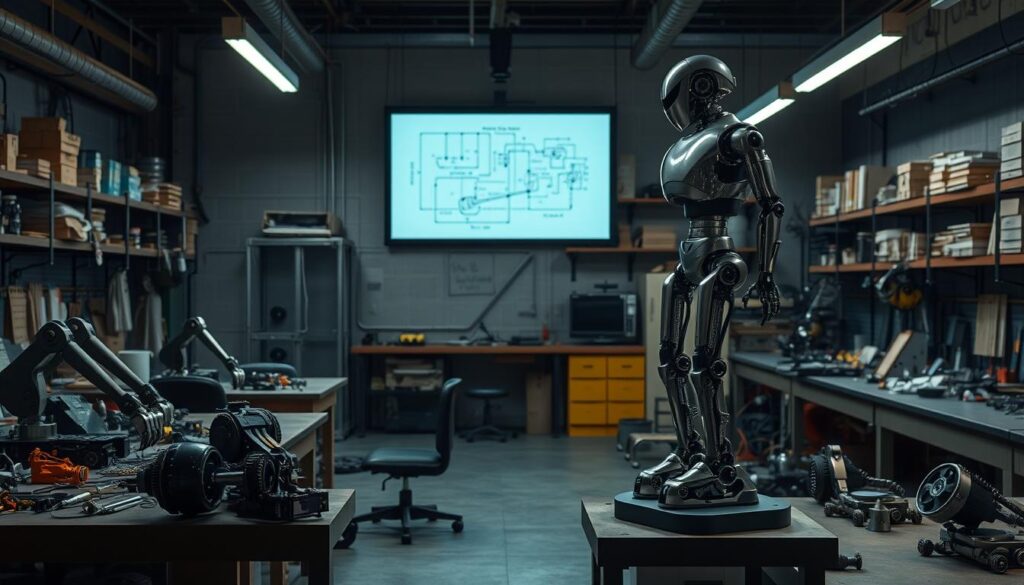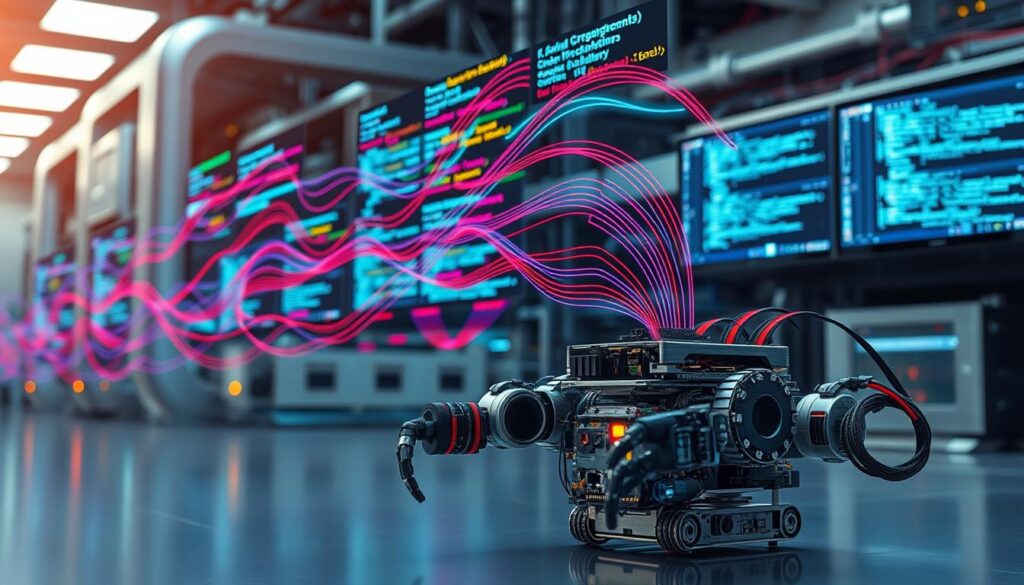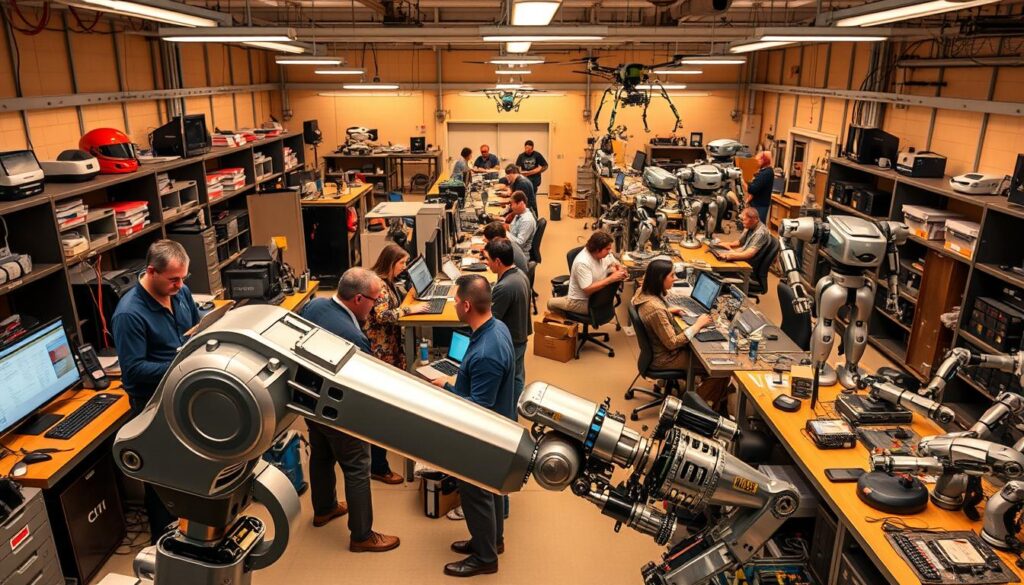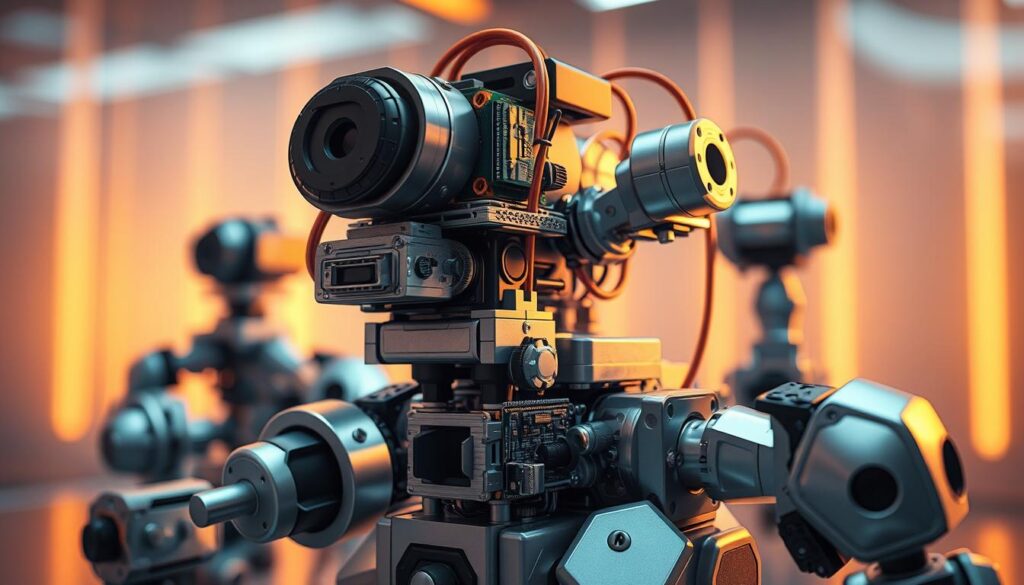The field of robotics engineering is transforming the way we live and work. With advancements in automation systems and artificial intelligence, robotics technology is revolutionizing industries worldwide.
From industrial automation to service robotics, robotics applications are diverse and continue to grow. As robotics research advances, we see significant improvements in machine learning and computer vision, enabling robots to perform complex tasks with precision.
The impact of robotics engineering on various industries is profound, enhancing efficiency and productivity. As technology continues to evolve, the future of robotics holds much promise.
Key Takeaways
- Robotics engineering is transforming industries through automation and AI.
- Advancements in robotics technology are improving efficiency and productivity.
- Applications of robotics range from industrial automation to service robotics.
- Robotics research is driving innovations in machine learning and computer vision.
- The future of robotics holds significant promise for technological advancements.
The Evolution of Robotics Engineering
Robotics engineering has evolved remarkably, bridging the gap between science fiction and reality. The field has undergone significant transformations since its inception, driven by technological advancements, economic needs, and societal demands.
From Science Fiction to Reality
The concept of robotics has long been a staple of science fiction, captivating the imagination of people worldwide. However, what was once considered the realm of fantasy has now become a tangible reality. The transition from fiction to reality has been facilitated by rapid advancements in technology, including improvements in mechanical engineering, electronics, and computer science.
Robotics engineering has not only caught up with the visions of science fiction writers but has also surpassed them in many ways. Today, robots are an integral part of various industries, from manufacturing to healthcare, and continue to expand into new areas.
Key Milestones in Robotics Development
The development of robotics has been marked by several key milestones. One of the earliest significant advancements was the introduction of industrial robots in the 1960s, which revolutionized manufacturing processes by increasing efficiency and precision.
- The development of the first programmable robot, known as “Unimate,” in 1954.
- Advances in sensor technology and artificial intelligence.
- The introduction of collaborative robots (cobots) designed to work alongside humans.
These milestones highlight the rapid progress in robotics technology and its expanding applications across various sectors.
Fundamentals of Robotics Engineering
Understanding the fundamentals of robotics engineering is crucial for developing efficient and reliable robotic systems. Robotics engineering is a multidisciplinary field that draws on knowledge from mechanical engineering, electrical engineering, computer science, and mathematics to design and develop robots that can perform complex tasks.

Core Principles and Concepts
The core principles of robotics engineering include understanding the kinematics and dynamics of robotic systems, which are essential for designing robots that can move and interact with their environment effectively. Kinematics involves the study of the motion of robots without considering the forces that cause the motion, while dynamics involves the study of the forces and their effects on the motion of robots.
Another key concept is control systems, which enable robots to perform tasks autonomously by regulating their movements and actions based on feedback from sensors.
Interdisciplinary Nature of the Field
Robotics engineering is inherently interdisciplinary, combining principles from various fields to create sophisticated robotic systems. For instance, mechanical engineering contributes to the design of the mechanical structure and components of robots, while electrical engineering is crucial for the development of the electronic systems that power and control robots.
Furthermore, software development plays a vital role in programming the behavior of robots, enabling them to perform complex tasks and interact with their environment.
| Discipline | Contribution to Robotics |
|---|---|
| Mechanical Engineering | Design of mechanical structure and components |
| Electrical Engineering | Development of electronic systems |
| Computer Science | Software development for robot behavior |
The Engineering Design Process for Robots
The engineering design process for robots involves several stages, from conceptualization to prototyping and testing. It begins with defining the requirements and specifications of the robot based on its intended application, followed by the design of the mechanical and electrical systems.
The next stage involves software development to program the robot’s behavior and control its movements. Finally, the robot is prototyped and tested to ensure it meets the desired performance and safety standards.
Essential Components of Robotic Systems
At the heart of every robotic system are several key components that enable its functionality. Robotic systems are made up of various critical elements that work together to allow the robot to perform tasks efficiently.
Mechanical Design and Actuators
The mechanical design of a robot is fundamental to its operation. It includes the structural elements and the actuators that provide movement.
Joints, Links, and End Effectors
Joints, links, and end effectors are crucial components of a robot’s mechanical design. Joints provide the flexibility and range of motion, while links are the rigid structures that connect these joints. End effectors, such as grippers or tools, are attached to the end of the robotic arm and are designed to interact with the environment.
Materials and Manufacturing Considerations
The choice of materials and manufacturing processes significantly impacts the robot’s performance and durability. Lightweight yet strong materials are often preferred to enhance efficiency and reduce energy consumption. Manufacturing considerations, such as precision and tolerances, are also critical in ensuring that the robot operates as intended.
Electronic Systems and Sensors
Electronic systems and sensors are vital for the control and operation of robotic systems. Sensors provide feedback to the control system, enabling the robot to perceive its environment and make decisions.
“The integration of advanced sensors and electronic systems is revolutionizing the field of robotics, enabling robots to perform complex tasks with greater precision and autonomy.”
Control Systems Architecture
The control systems architecture is the backbone of a robotic system, governing how the robot responds to inputs and executes tasks. It involves sophisticated algorithms and software that process sensor data and control the actuators.
Effective control systems architecture is crucial for achieving precise and reliable robot performance. It requires a deep understanding of both the hardware and software components of the robotic system.
Programming and Software in Robotics
The field of robotics relies heavily on advanced programming and software to create robots that can adapt and learn. As robotics continues to evolve, the importance of sophisticated software development cannot be overstated.
Robotics programming involves a range of activities, from simple task automation to complex decision-making processes. The choice of programming languages and frameworks is critical in determining the capabilities of a robotic system.
Common Programming Languages and Frameworks
Several programming languages are commonly used in robotics, including Python, C++, and Java. These languages offer a range of libraries and frameworks that simplify the development of robotic applications. For instance, Python’s simplicity and extensive libraries make it a popular choice for robotics programming.

Frameworks such as Robot Operating System (ROS) provide a structured environment for developing robotic applications. ROS offers a comprehensive set of tools and libraries that facilitate the development of complex robotic systems.
Robot Operating System (ROS)
ROS is an open-source software framework that has become a standard in the robotics community. It provides a flexible and modular environment for developing robotic applications, allowing developers to integrate various components and libraries seamlessly.
Simulation Tools and Digital Twins
Simulation tools and digital twins play a crucial role in robotics development, enabling developers to test and validate robotic systems in a virtual environment. This approach reduces the need for physical prototypes, saving time and resources. Simulation tools allow for the simulation of various scenarios, helping to identify potential issues before deployment.
In conclusion, programming and software development are essential components of robotics engineering. By leveraging the right programming languages, frameworks, and simulation tools, developers can create sophisticated robotic systems that can perform complex tasks.
Artificial Intelligence in Robotics Engineering
The integration of Artificial Intelligence (AI) in Robotics Engineering is revolutionizing the way robots are designed and function. AI is enabling robots to become more autonomous, flexible, and capable of performing complex tasks. This transformation is driven by advancements in various AI disciplines, including machine learning, computer vision, and natural language processing.
Machine Learning Applications
Machine learning is a critical component of AI in robotics, allowing robots to learn from experience and improve their performance over time. There are several machine learning techniques used in robotics, including supervised and reinforcement learning.
Supervised and Reinforcement Learning for Robots
Supervised learning involves training robots using labeled data, enabling them to make predictions or take actions based on that data. Reinforcement learning, on the other hand, allows robots to learn through trial and error by interacting with their environment and receiving rewards or penalties for their actions.
Neural Networks for Motion Planning
Neural networks are being increasingly used in robotics for motion planning, enabling robots to navigate complex environments and avoid obstacles. These networks can be trained using various algorithms, including deep learning techniques.
Computer Vision Systems
Computer vision is another essential aspect of AI in robotics, enabling robots to perceive and understand their environment. Computer vision systems use cameras and sensors to capture data, which is then processed using algorithms to detect objects, track movement, and recognize patterns.
- Object detection and recognition
- Scene understanding
- Tracking and motion analysis
Natural Language Processing for Human-Robot Interaction
Natural Language Processing (NLP) is being used to enhance human-robot interaction, enabling robots to understand and respond to voice commands. NLP involves processing and generating human language, allowing robots to communicate effectively with humans.
Key benefits of NLP in robotics include:
- Improved human-robot interaction
- Enhanced robot autonomy
- Increased efficiency in task execution
In conclusion, AI is transforming Robotics Engineering by enabling robots to learn, perceive, and interact with their environment. The applications of machine learning, computer vision, and NLP are driving innovation in robotics, leading to more sophisticated and capable robotic systems.
Robotics Engineering Education and Required Skills
The field of robotics engineering demands a robust academic background and a blend of technical expertise and interpersonal skills. As robotics continues to evolve and integrate into various industries, the need for professionals with the right education and skills is becoming increasingly important.
Academic Pathways and Degree Programs
Robotics engineering education typically involves interdisciplinary programs that combine elements of mechanical engineering, electrical engineering, computer science, and mathematics. Many universities now offer specialized degree programs in robotics engineering, providing students with a comprehensive understanding of robotic systems, from design and development to implementation and maintenance. According to Dr. Henrik Christensen, Director of the Contextual Robotics Institute, “Robotics is an interdisciplinary field that requires a broad-based education to tackle the complex challenges of modern robotics.”
Some of the key subjects covered in robotics engineering programs include:
- Robot kinematics and dynamics
- Sensor integration and computer vision
- Machine learning and artificial intelligence
- Control systems and programming languages
Technical Skills and Competencies
Professionals in robotics engineering require a strong foundation in technical skills, including programming languages such as Python, C++, and MATLAB. They must also be proficient in using robotics software frameworks like ROS (Robot Operating System) and have a good understanding of mechanical design, electronic systems, and control systems. “The ability to program and interact with robotic systems is crucial,” notes Prof. Maja Matarić, a renowned robotics expert.

Soft Skills and Interdisciplinary Knowledge
Beyond technical skills, robotics engineers must possess soft skills such as teamwork, communication, and problem-solving. The ability to work effectively in interdisciplinary teams is crucial, as robotics projects often involve collaboration between engineers, researchers, and industry experts. As
“The future of robotics lies not just in the technology itself, but in how effectively we can integrate it into our societies and economies,”
highlights the importance of soft skills in robotics engineering.
By combining a strong academic foundation with both technical and soft skills, individuals can excel in the dynamic and rapidly evolving field of robotics engineering.
Major Applications of Robotics Engineering
Robotics engineering is revolutionizing multiple sectors, including manufacturing, healthcare, and consumer services. The diverse applications of robotics are transforming industries, enhancing efficiency, and driving innovation.
Industrial Automation and Manufacturing
Industrial automation is one of the primary applications of robotics engineering. Robots are being used to streamline manufacturing processes, improve product quality, and reduce production costs.
Assembly Line Robotics
Assembly line robots are being used to perform tasks such as welding, assembly, and inspection. These robots are equipped with advanced sensors and AI algorithms, enabling them to work alongside human workers and improve overall efficiency.
Quality Control and Inspection Systems
Robots are also being used for quality control and inspection in manufacturing. Equipped with computer vision systems, these robots can detect defects and anomalies, ensuring that products meet the required standards.
Healthcare and Medical Robotics
Robotics engineering is also making significant contributions to the healthcare sector. Medical robots are being used for surgeries, patient care, and rehabilitation.
These robots are designed to enhance the precision and accuracy of medical procedures, improving patient outcomes and reducing recovery times.
Space Exploration and Defense Applications
Robotics engineering is playing a crucial role in space exploration and defense. Robots are being used in space missions to perform tasks such as sample collection and terrain exploration.
In defense, robots are being used for surveillance, reconnaissance, and combat operations, enhancing the capabilities of military forces.
Consumer and Service Robotics
The consumer and service robotics sector is also growing rapidly. Robots are being used in various applications, including household chores, customer service, and entertainment.
These robots are designed to be user-friendly and are equipped with advanced AI algorithms, enabling them to interact with humans and perform tasks efficiently.
Emerging Trends in Robotics Technology
Emerging trends in robotics technology are not only enhancing existing applications but also opening up new possibilities. The field is witnessing significant advancements that are poised to revolutionize various industries. From improved autonomy to enhanced human-robot interaction, these trends are shaping the future of robotics engineering.

Autonomous Vehicles and Drones
Autonomous vehicles and drones are at the forefront of robotics innovation. These systems are being increasingly adopted across various sectors, including logistics, agriculture, and surveillance. Autonomous vehicles are equipped with advanced navigation systems, enabling them to operate without human intervention. Similarly, drones are being used for aerial surveys, package delivery, and even in search and rescue operations. The integration of AI and machine learning algorithms is further enhancing their capabilities, making them more efficient and reliable.
The applications of autonomous vehicles and drones are vast and varied. In agriculture, for instance, drones are used for crop monitoring and precision farming. In logistics, autonomous vehicles are being tested for last-mile delivery. These technologies are not only improving operational efficiency but also reducing costs and enhancing safety.
Collaborative Robots (Cobots)
Collaborative robots, or cobots, are designed to work alongside humans, enhancing productivity and safety in the workplace. Unlike traditional industrial robots that are often segregated from human workers, cobots are equipped with sensors and AI algorithms that enable them to interact safely with humans. This trend is particularly significant in manufacturing, where cobots are being used to assist workers with tasks that require precision and strength.
The adoption of cobots is driven by their flexibility and ease of use. They can be easily programmed and redeployed as needed, making them ideal for small and medium-sized enterprises. Moreover, cobots are enhancing workplace safety by taking over hazardous tasks, thereby reducing the risk of injuries.
Soft Robotics and Biomimetic Design
Soft robotics and biomimetic design are emerging trends that focus on creating robots that can interact safely with delicate or unpredictable environments. Soft robotics involves the use of flexible, compliant materials that can adapt to various situations, much like human skin. Biomimetic design, on the other hand, involves designing robots that mimic nature, such as robotic insects or animals.
These trends are particularly relevant in healthcare, where robots need to interact with humans in a safe and gentle manner. For instance, robotic grippers inspired by the octopus are being developed for handling fragile objects. Similarly, biomimetic robots are being designed for search and rescue operations, where they can navigate through rubble or debris.
The Global Robotics Industry Landscape
With the integration of cutting-edge technologies, the global robotics industry is poised for substantial expansion and diversification. The industry’s growth is driven by advancements in artificial intelligence, machine learning, and sensor technologies, which are enhancing the capabilities of robots across various sectors.
Leading Companies and Innovative Startups
The global robotics industry is characterized by the presence of both established companies and innovative startups. Leading companies such as Fanuc, KUKA, and ABB are driving the industry forward with their advanced robotic solutions. Meanwhile, startups like Kindred AI and Skydio are introducing innovative products and services that are disrupting traditional robotics markets.
| Company | Specialization | Notable Achievements |
|---|---|---|
| Fanuc | Industrial Robotics | Developed the world’s first all-electrical servo-driven robot |
| KUKA | Industrial Automation | Pioneered the use of robots in automotive manufacturing |
| ABB | Robotics and Automation | Introduced the world’s fastest robot, the IRB 1200 |
Investment Trends and Market Growth
The robotics industry is witnessing significant investment from venture capitalists, corporate investors, and government institutions. According to recent reports, the global robotics market is expected to grow at a CAGR of over 10% in the next five years. This growth is driven by increasing demand for automation in manufacturing, healthcare, and logistics.
Regional Robotics Hubs and Innovation Centers
The global robotics industry is also characterized by the emergence of regional robotics hubs and innovation centers. Regions such as Silicon Valley in the United States, Singapore, and South Korea are becoming hotbeds for robotics innovation, with many startups and established companies setting up operations in these areas. These hubs are fostering collaboration, innovation, and the development of new robotic technologies.
As the global robotics industry continues to evolve, it is likely that we will see further advancements in robotic technologies, leading to increased adoption across various sectors and geographies.
Robotics Engineering Career Opportunities
Robotics engineering careers are becoming increasingly diverse, with opportunities spanning multiple sectors and specializations. As technology continues to advance, the demand for skilled robotics engineers is on the rise, driven by the need for innovative solutions across industries.
Job Roles and Specializations
The field of robotics engineering encompasses a wide range of job roles and specializations. Some of the key areas include:
- Design and development of robotic systems
- Programming and software development for robots
- Integration of artificial intelligence and machine learning in robotics
- Robotics system testing and validation
- Maintenance and repair of robotic systems
Robotics engineers can specialize in areas such as mechanical engineering, electrical engineering, computer science, or a combination of these disciplines. Specializations can also be industry-specific, such as automotive, healthcare, or aerospace.

Salary Prospects and Industry Demand
The salary prospects for robotics engineers are promising, with median salaries ranging from $80,000 to over $120,000 depending on experience, location, and industry. The demand for robotics engineers is high across various sectors, including manufacturing, healthcare, logistics, and defense.
| Industry | Median Salary | Demand Level |
|---|---|---|
| Manufacturing | $90,000 | High |
| Healthcare | $100,000 | Very High |
| Logistics | $85,000 | High |
| Defense | $110,000 | Very High |
Building a Successful Career Path
To build a successful career in robotics engineering, it’s essential to stay updated with the latest technologies and advancements. This can be achieved through continuous learning, attending industry conferences, and participating in relevant projects. Networking with professionals in the field and joining robotics-related organizations can also provide valuable opportunities for growth.
By focusing on developing a strong foundation in robotics principles, gaining practical experience, and adapting to the evolving landscape of the industry, individuals can position themselves for success in this exciting and rapidly growing field.
Ethical Considerations and Challenges in Robotics
The rapid evolution of robotics technology brings forth a myriad of ethical dilemmas that need careful consideration. As robotics engineering continues to advance, it’s essential to address the ethical considerations and challenges that arise from its development and deployment.
Automation and Employment Impact
One of the significant ethical concerns is the impact of automation on employment. As robots and automated systems become more prevalent, there’s a growing concern about job displacement. According to a report by the McKinsey Global Institute, up to 800 million jobs could be lost worldwide due to automation by 2030. However, it’s also important to note that while automation may replace some jobs, it could also create new ones, such as in fields related to robotics maintenance and programming.
| Industry | Jobs Lost | Jobs Created |
|---|---|---|
| Manufacturing | Assembly Line Workers | Robotics Engineers |
| Transportation | Drivers | Autonomous Vehicle Developers |
Safety Standards and Regulatory Frameworks
Ensuring safety in robotics is another critical challenge. As robots become more integrated into daily life, establishing robust safety standards and regulatory frameworks is crucial. Organizations such as the International Organization for Standardization (ISO) are working on developing guidelines for the safe design and use of robots.
Key aspects of safety standards include:
- Risk assessment and mitigation
- Design and construction guidelines
- Operator training and safety protocols
Responsible Innovation Principles
Applying responsible innovation principles in robotics engineering is vital to ensure that technological advancements benefit society while minimizing risks. This involves considering the ethical implications of robotics development and deployment, engaging stakeholders, and fostering transparency.
Responsible innovation in robotics entails:
- Ethical consideration of technology impact
- Stakeholder engagement and participation
- Transparency in development and deployment processes

By addressing these ethical considerations and challenges, the field of robotics engineering can continue to evolve in a way that is beneficial and responsible.
The Future of Robotics Engineering
The future of robotics engineering is poised to revolutionize various aspects of our lives. As we look to the horizon, it’s clear that robotics will continue to evolve, driven by technological advancements and innovative applications.
Robotics engineering has come a long way since its inception, and the next decade promises to be particularly exciting. With the integration of artificial intelligence, machine learning, and the Internet of Things (IoT), robots are becoming increasingly sophisticated.
Predicted Technological Breakthroughs
Several technological breakthroughs are expected to shape the future of robotics engineering. These include:
- Advances in artificial intelligence and machine learning algorithms that enable robots to learn from experience and adapt to new situations.
- Improvements in sensor technologies and computer vision that enhance a robot’s ability to perceive and interact with its environment.
- Development of more sophisticated human-robot interaction systems that allow for more natural and intuitive communication between humans and robots.

Integration with Other Emerging Technologies
The future of robotics is closely tied to its integration with other emerging technologies. For instance:
| Emerging Technology | Impact on Robotics |
|---|---|
| Internet of Things (IoT) | Enables robots to connect with other devices and systems, enhancing their functionality and autonomy. |
| 5G Networks | Provides faster and more reliable communication, facilitating remote operation and real-time data transfer. |
| Blockchain | Offers secure and transparent data management, which can be crucial for robotics applications in industries like healthcare and finance. |
Societal and Economic Implications
The advancements in robotics engineering will have significant societal and economic implications. On one hand, robotics can lead to increased productivity and efficiency, driving economic growth. On the other hand, it may also lead to job displacement in certain sectors. Therefore, it’s crucial to invest in education and retraining programs that prepare workers for the changing job landscape.
In conclusion, the future of robotics engineering holds much promise, with potential breakthroughs in technology and integration with other emerging fields. As we move forward, it’s essential to consider the broader societal and economic implications to ensure that the benefits are equitably distributed.
Conclusion
Robotics Engineering is revolutionizing the way we live and work, transforming industries and enabling new possibilities. As explored in this article, the field encompasses a broad range of applications, from industrial automation to service robotics, and is poised to have a significant impact on our daily lives.
The future of robotics holds much promise, with advancements in artificial intelligence, machine learning, and computer vision driving innovation. As Robotics Engineering continues to evolve, it is crucial to consider the potential benefits and challenges that arise, ensuring responsible development and deployment.
By understanding the fundamentals, applications, and emerging trends in Robotics Engineering, we can better navigate the opportunities and complexities that this field presents. As we move forward, it is clear that Robotics Engineering will play a vital role in shaping the future of technology and society.
